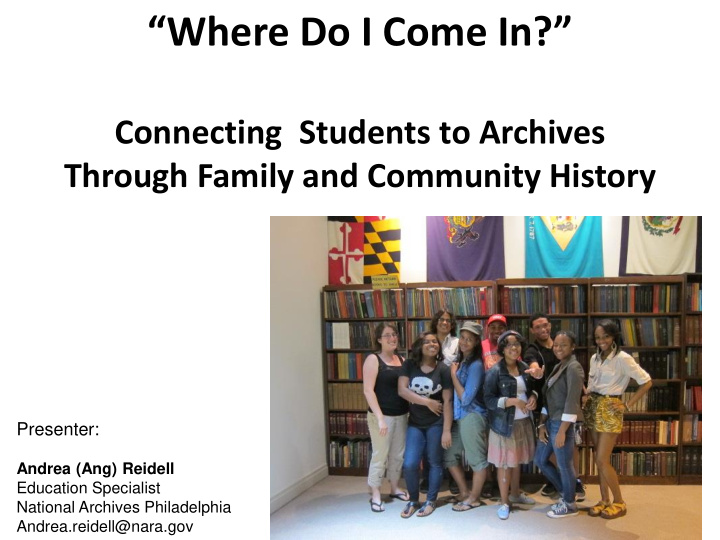



“Where Do I Come In?” Connecting Students to Archives Through Family and Community History Presenter: Andrea (Ang) Reidell Education Specialist Andrea (Ang) Reidell National Archives at Philadelphia Education Specialist Andrea.reidell@nara.gov National Archives Philadelphia Andrea.reidell@nara.gov
National Archives at Philadelphia Student Family History Initiative Multifaceted Goals: • Reach out to students of all ages, particularly youth of color
Spark a connection to & a deeper interest in history
• Encourage lifelong critical thinking and research skills
• Teach students how to discover their family stories
• Connect students with National Archives resources
• Help students recognize how their family story fits into larger historical narratives.
Facilitate students’ understanding that they are an important part of the history - and future - of their communities
Student Family History Initiative – The Beginning Pilot project: Family History Summer Institute for Students • Three years: 2010 - 2012 Partnerships – key: • National Archives at Philadelphia • Genealogical Society of Pennsylvania • Constitution High School (2010)
The Details • Small group of high school students each summer. • 6-8 hours/week of guided family history research with Project Coordinators and mentors. • Visited area archives and libraries to meet staff, learn about the holdings, and conduct research. • Making it work for Philadelphia’s students: transportation subsidy and (some years) a small stipend.
Putting It All Together Final project: • Websites or Prezis describing process and results. • Presented at a public program at the National Archives at Philadelphia. • Program Attendees: – students’ families • First time ever in a National Archives facility – educators – cultural community members – genealogists – general public
Student participation • “My mother considers herself just black and I say I am mixed, so she told me to talk to my grandparents. When I spoke to them they said that my great 3x grandfather was the son of a slave master…so it struck my mind [that this project] is exactly what I was looking for to help me in this.” - Family History Summer Institute Applicant
Frustrations and Successes "Finding census, marriage records, death index, and public records was very time consuming and frustrating at the same time, but when you found a primary document it was a wonderful feeling of accomplishment." – Maria, 2010 participant, 2011 Peer Mentor
Research Accomplishments • “ The first name I looked up...was my [great] x4 grandfather. It took me a while but I found him in [Virginia] 1880 census records.... I ran to the file cabinet where the National Archives held the census microfilms. I would say that looking though the microfilm manually was the best part. It made me feel I could touch what they touched .” – Kendall, 2010 participant
Student Family History Initiative - Next steps • Began to expand programming into the school year, on a smaller-scale • Workshops for students from 6 th - 12 th grade, a dapted for age level. • Working with teachers on how to use family history in the classroom • Development of a Family History Packet • Now working with ESOL teachers at Philadelphia Writing Program at UPenn (from Esperanza project) • Large-scale partnership opportunity: Esperanza Academy Charter School
Esperanza Academy Charter School • North Philadelphia – 301 W Hunting Park Ave • Demographics: – 92% Hispanic – 8% African-American • Enhancing social studies curriculum – Latino/African American studies class
“La Historia de Mi Familia” • Working closely with the teachers, developed a rigorous family and neighborhood history project. • Two successful years and already planning the third. • Almost 400 9 th graders to date.
• In-class visits for workshops on primary document analysis, source perspective and working with the census. • School subscribed to ancestry.com • Field trips to cultural institutions reinforce/enhance classroom learning directed research and more primary source analysis
Workshop - U.S. Census • School visit from National Archives staff members • Overview of importance of census to family and community life • Document analysis: compare and contrast 1930 and 1940 census
The Final Product 1 st year: 30 students chosen to develop their work into an exhibit at the National Archives. 3-dimensional mobiles on tree branches Mobiles included laminated copies: • documents • oral history interview transcripts • photos
• La Historia de Mi Familia – the National Archives first bilingual exhibit. • Students worked in English • All translations done by a former National Archives graduate fellow in Education
2 nd year: – Exhibit host: National Museum of American Jewish History Student Projects: • 30 Exhibits • 10 web sites Up for three months
Opening Night of the Exhibit • Students, families and community members invited. • School provided bus transportation to the exhibit site.
• Proud family members attended. • As with summer institute, many attendees had not heard of National Archives
• Students present an overview of the project and what he/she learned – about history and themselves.
Comments from parents and students Rough Spanish translation: Very cool to learn about our roots!
And visitors to the exhibit Comment in Spanish, English and Hebrew: “We are all family.” The students’ work stimulates interest in family history for visitors: “I loved this exhibition!...It made me want to explore my own ancestry.”
Points to Consider • This project is scalable and adaptable – What will work best in your institutional context? • Listen and learn FIRST – then adapt what you can offer to meet the school’s needs. • Be flexible!! • Start small and build on success.
Summing Things Up • Family history projects are a great way to connect with students. • Pathways to success for ALL students. • Also works well to connect with students’ families. • Great community outreach. • Not easy, but absolutely worth it.
A Few Final Thoughts Video Clips: Danny Cortes, Executive Vice-President and Chief of Staff, Esperanza Kennyshia Paulino, Student Participant David Rossi Senior Vice President and CEO of Esperanza Charter Schools
Recommend
More recommend